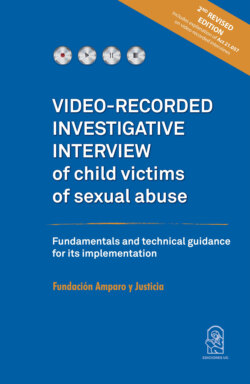Читать книгу Video-Recorded investigative interview of child victims of sexual abuse - Fundación Amparo y Justicia - Страница 9
На сайте Литреса книга снята с продажи.
3. The experience of child victims of sexual abuse in the justice system
ОглавлениеHalf of the children in the world ―more than one billion― experience some form of violence each year (Hillis, Mercy, Amobi and Kress, 2016). This is extremely worrying, since abuse (in a broad sense) can profoundly affect a child’s cognitive, socio-economic and even physical development (Malloy, La Rooy, Lamb and Katz, 2011).
Regarding sexual violence, the latest UNICEF report (2017), which compiles information from the most recent national surveys on violence against children, concludes that worldwide around 15 million adolescent girls aged 15 to 19 have experienced forced sex in their lifetime12 . Of the 46 countries with available data, there are significant variations at the national level in the proportion of women who were exposed to some form of sexual violence during their childhood, ranging from less than 1% to 24.8%, the average being 5% (UNICEF, 2019).
In Chile, according to the First National Survey on the Poly-victimization of Children (Consejo Nacional de la Infancia, 2018), 26% of those surveyed, corresponding to 19,684 children aged 12 to 17, reported having suffered at least some type of sexual victimization13 during their lives, and 17% in the last year (20% women and 14% men). Likewise, according to data from the Public Prosecutor’s Office (2020), between 2015 and 2019, the reported annual average of child victims of sexual assault was approximately of 19,00014, with an increase from 14,959 in 2015 to 24,593 in 2019.
One of the greatest challenges faced by the justice system when dealing with a sex crime is the lack of background information available for the investigation and the subsequent resolution of the case. For example, it is common for no physical signs of abuse to appear in the medical examination, either because there were no injuries due to the way the crime was committed or because the injuries had already healed over time. On the other hand, the examination might have been performed with an inadequate technique or by a doctor without enough specialized experience, among other factors (Adams, Farst and Kellogg, 2018; JUFEJUS, ADC and UNICEF, 2013; Lanning, 2002; Lewy, Cyr and Dion, 2015; Randell, 2011)15. The general rule is that the only evidence available to prove or refute the occurrence of the facts and the participation of the accused is the victim’s testimony. Their account is essential for finding evidence to corroborate the reported facts, to uncover other possible criminal acts and to order protective measures. This is why obtaining and preserving their testimony is critical (Burrows and Powell, 2014; Johnson and Shelley, 2014; Lyon, 2014; Pipe, Orbach, Lamb, Abbott and Stewart, 2013).
Although an increasing number of countries have been incorporating special protective measures for victims, the historical dependence of the criminal justice process on victims’ accounts has turned them into tools for investigation, rather than persons with rights (Berlinerblau, 2009). As a result, they continue to be exposed to an excessive number of interviews, many of which are not conducted protecting their dignity or psychological integrity. Studies conducted in the United States indicate that victims must face between two and six formal interrogations (Quas and Sumaroka, 2011). An investigation carried out in Chile found similar figures (two to seven interviews)16 (MIDE UC, 2009).
Being subjected to many interviews can be very distressing for children, as they are forced to relive and talk about painful or traumatic memories and experiences (AIAMP, 2008; Rosendo Cantú and others vs. Mexico, paragraph No. 201; Ibero-American Judicial Summit, 2008; La Rooy, Katz, Malloy and Lamb, 2010; Rodríguez Collao, 2014). In fact, organizations responsible for the care of child victims and their families report their disappointment when facing the criminal process and their regret in having made a complaint17. This is due to the child’s exposure to multiple interviews and other proceedings, which does not necessarily end with the conviction of the perpetrator (MIDE UC, 2009; Fundación para la Confianza and Centro de Estudios de la Niñez, Corporación Opción, 2012). As UNICEF and ICSO UDP (Instituto de Investigación en Ciencias Sociales, Universidad Diego Portales)point out, “in practice, [the testimony] must be repeated many times during the various stages of the judicial process, even though this may be contrary to the child victim’s reparation process” (2006, p. 63). In fact, studies have reported a number of characteristics of judicial processes that can negatively influence the behavior and mental health of child victims, including multiple interrogations, delays in proceedings, case outcomes, and also the type of support they receive from their caregivers (Quas and Goodman, 2012).
These effects are intensified when interventions are not strictly necessary or involve an overlap of similar evaluations (JUFEJUS et al., 2013), which also interferes with the children’s recovery process (Myers, 2005). As Moreno points out, the possible negative consequences that victims experience during criminal proceedings are not necessarily the result of the defendant’s defense, but rather are produced “through the successive and repeated interviews or interrogations to which the victim is subjected during the investigation stage, by persons [sic] and using methodologies that are often entirely questionable” (2013, p. 115).
Thus, the institutions and individuals involved in the process become a potential source of secondary victimization, without any guarantee that their intervention will directly result in an adequate resolution of the case18.
On the other hand, in addition to the possible effects on the victim, multiple interviews of the child can have negative consequences for the justice system itself. When testimonies are not taken properly or there are long delays in obtaining statements, it may result in the victim’s memories of the reported events ―the central evidence of the process― becoming more susceptible to errors and potential contamination (Lamb, Hershkowitz, Orbach and Esplin, 2018; La Rooy, Lamb and Pipe, 2008)19.
